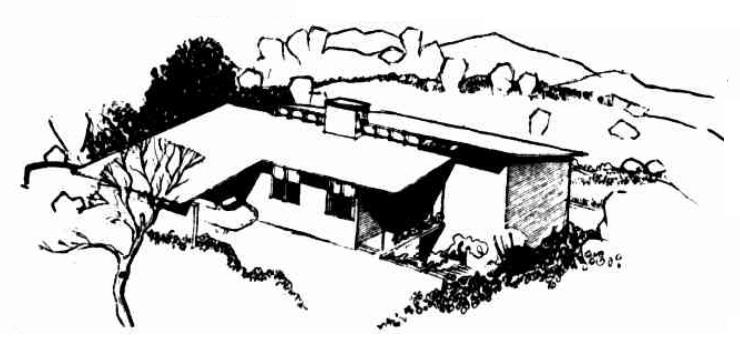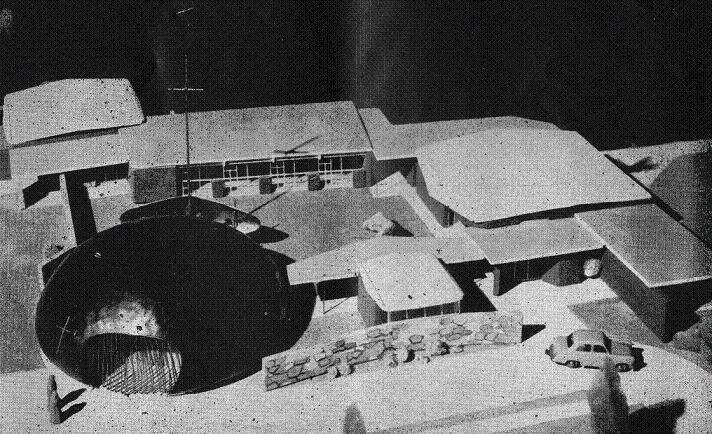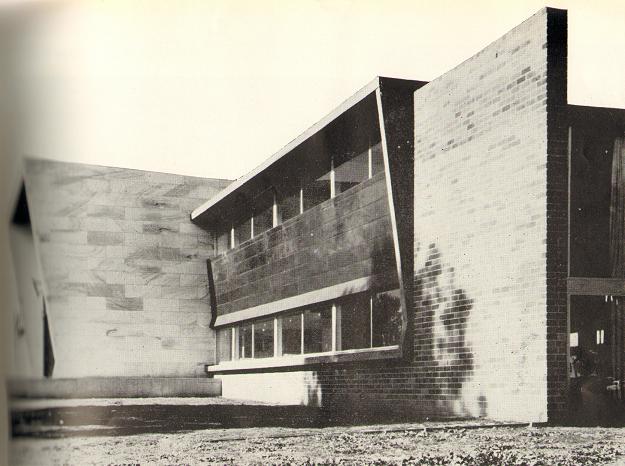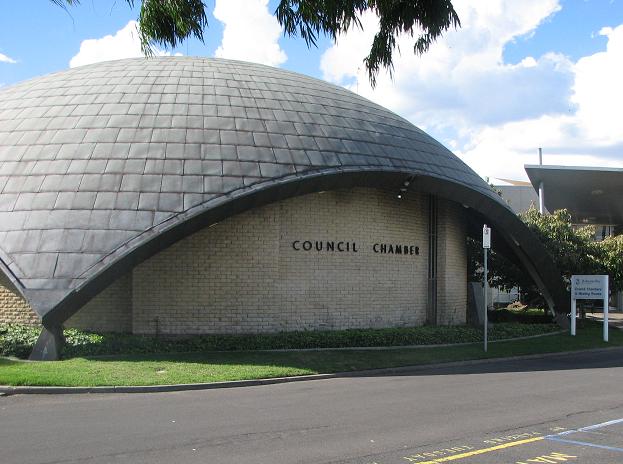Robert George Warren was born on 30 July 1920 in Somerville on
Victoria's Mornington Peninsula. In 1936, he matriculated
from Huntingtower College in Melbourne and enrolled in the
Diploma of Architecture course at the Melbourne Technical College.
Concurrent with his studies, he spent 3½ years employed in the
architectural office of Leslie M Perrott & Partners, during which
time he mostly worked, by his own account, on industrial and hotel
projects (the latter, presumably, including Perrott's celebrated Hotel
Australia in Collins Street). While still working there, Warren
entered a design competition held in association with the 1939 Home
& Building Exhibition; his contribution, for a small gabled house
"suitable for seaside or country", was one of the twelve shortlisted
entries. In June 1941, Warren enlisted in
the Australian Army and served with the Royal Australian Engineers for
the next five years. After studying at the School of Military
Engineering in Sydney for four months, he became a commissioned officer
and spent 18 months in the Pacific Islands followed by thee years in
Australia, during which time was involved with "constructional work of
all kinds”, including camps, hospitals, bridges and roads". He
was
discharged from military service in September 1945 with the rank of
Lieutenant.
Returning to civilian life, Warren went back to the office of Leslie M Perrott and continued working there until at least April 1946. He subsequently established his own practice, working from modest premises above a shop in Balcombe Road, Black Rock. Business evidently flourished during 1947, as he advertised for the services of an employee draftsman in March, followed by a typist in May. By October, he had transferred his office to a city address at 309 Spring Street. During a period when private construction was hampered by wartime restrictions enforced by the State Building Directorate, Warren was fortunate in securing several commissions for group housing. The Caulfield Central sub-branch of the RSL engaged him to design a group of thirty "simple but attractive" low-cost dwellings in Beaumaris - a project that caught the attention of the property reporter for the Argus newspaper, who lauded Warren's use of timber construction and standardised detailing to ensure economy of labour and materials. The architect went on to design several similar housing estates at Sandringham, Essendon, Moorabbin and St Albans. In 1949, Warren's scheme for his own house at Ivanoe - a modest but progressive split-level open-planned dwelling - also appeared in the Argus property column, lauded as "evidence of an open mind, trained in contemporary attitudes and skilled in expedients".
At some point in the late 1940s, Warren entered into a brief partnership with fellow architect John R Tovey; this association, however, was dissolved "by mutual consent" in August 1949. Within a few years, Warren and his wife Joyce had moved permanently to Canberra, although he maintained his registration as an architect in Victoria until as late as 1961. In July 1953, it was reported in the Canberra Times that "the Canberra branch of the Melbourne architectural firm of R B Hocking and R G Warren" had officially opened, with offices in Capital Chambers, Civic Centre. Warren's practice in the ACT is known to have encompassed residential, civic, ecclesiastical and institutional projects. In September 1954, a house that he designed for a doctor was one of eight local residences "of outstanding architectural interest" that were opened to the public as a special fundraising event for International House, the new overseas students' hostel then being proposed by the University of Melbourne. In December of that year, he was one of several Canberra architects invited to lecture at a five-day "Homemaker's School" sponsored by the Hall Junior Farmer's Club.
Also during 1954, Robert Warren's office was one of six firm (along with Grounds Romberg & Boyd, Fowell Mansfield & Maclurcan, Hassell & McConnell, Borland Murphy & McIntyre and Mockridge Stahle & Mitchell) invited to prepare schemes for the new Academy of Science building at Canberra. Although the commission was ultimately awarded to Roy Grounds, who proposed a bold circular building with shell-concrete dome, Warren was one of two fellow competitors (the other being Borland, Murphy & McIntyre) who proposed buildings of similar form and structure.
For his part, Warren remained extremely interested in shell concrete domes for some time; a few years later, in 1958, he prepared a scheme for St Phillip's Church of England in the Canberra suburb of O'Connor, which included a circular domed chapel of a blob-like form that "suggests the tense balance of drop of water on a flat surface". Although the chapel was never actually built to this bold design, it nevertheless garnered considerable attention. Drawings appeared on the cover of Architecture & Arts journal, and, with assistance from Robin Boyd, Warren even attempted (without success) to have the project published in US-based Architectural Record. Warren went on to incorporate shell-concrete technology - this time in the form of elongated sausage-shaped vaults - into a subsequent project for the Queanbeyan Recreation & Leisure Centre, which was completed in 1961. Later that year, he revived the saucer-dome motif again, as the council chamber for the new Altona Civic Centre – his last known project in his home state of Victoria.
In 1969, Warren left Australia to work as a consultant on a low-cost housing project in Indonesia for the United Nations development programme. He subsequently returned to Canberra, where he died in July 2002.
Returning to civilian life, Warren went back to the office of Leslie M Perrott and continued working there until at least April 1946. He subsequently established his own practice, working from modest premises above a shop in Balcombe Road, Black Rock. Business evidently flourished during 1947, as he advertised for the services of an employee draftsman in March, followed by a typist in May. By October, he had transferred his office to a city address at 309 Spring Street. During a period when private construction was hampered by wartime restrictions enforced by the State Building Directorate, Warren was fortunate in securing several commissions for group housing. The Caulfield Central sub-branch of the RSL engaged him to design a group of thirty "simple but attractive" low-cost dwellings in Beaumaris - a project that caught the attention of the property reporter for the Argus newspaper, who lauded Warren's use of timber construction and standardised detailing to ensure economy of labour and materials. The architect went on to design several similar housing estates at Sandringham, Essendon, Moorabbin and St Albans. In 1949, Warren's scheme for his own house at Ivanoe - a modest but progressive split-level open-planned dwelling - also appeared in the Argus property column, lauded as "evidence of an open mind, trained in contemporary attitudes and skilled in expedients".
At some point in the late 1940s, Warren entered into a brief partnership with fellow architect John R Tovey; this association, however, was dissolved "by mutual consent" in August 1949. Within a few years, Warren and his wife Joyce had moved permanently to Canberra, although he maintained his registration as an architect in Victoria until as late as 1961. In July 1953, it was reported in the Canberra Times that "the Canberra branch of the Melbourne architectural firm of R B Hocking and R G Warren" had officially opened, with offices in Capital Chambers, Civic Centre. Warren's practice in the ACT is known to have encompassed residential, civic, ecclesiastical and institutional projects. In September 1954, a house that he designed for a doctor was one of eight local residences "of outstanding architectural interest" that were opened to the public as a special fundraising event for International House, the new overseas students' hostel then being proposed by the University of Melbourne. In December of that year, he was one of several Canberra architects invited to lecture at a five-day "Homemaker's School" sponsored by the Hall Junior Farmer's Club.
Also during 1954, Robert Warren's office was one of six firm (along with Grounds Romberg & Boyd, Fowell Mansfield & Maclurcan, Hassell & McConnell, Borland Murphy & McIntyre and Mockridge Stahle & Mitchell) invited to prepare schemes for the new Academy of Science building at Canberra. Although the commission was ultimately awarded to Roy Grounds, who proposed a bold circular building with shell-concrete dome, Warren was one of two fellow competitors (the other being Borland, Murphy & McIntyre) who proposed buildings of similar form and structure.
For his part, Warren remained extremely interested in shell concrete domes for some time; a few years later, in 1958, he prepared a scheme for St Phillip's Church of England in the Canberra suburb of O'Connor, which included a circular domed chapel of a blob-like form that "suggests the tense balance of drop of water on a flat surface". Although the chapel was never actually built to this bold design, it nevertheless garnered considerable attention. Drawings appeared on the cover of Architecture & Arts journal, and, with assistance from Robin Boyd, Warren even attempted (without success) to have the project published in US-based Architectural Record. Warren went on to incorporate shell-concrete technology - this time in the form of elongated sausage-shaped vaults - into a subsequent project for the Queanbeyan Recreation & Leisure Centre, which was completed in 1961. Later that year, he revived the saucer-dome motif again, as the council chamber for the new Altona Civic Centre – his last known project in his home state of Victoria.
In 1969, Warren left Australia to work as a consultant on a low-cost housing project in Indonesia for the United Nations development programme. He subsequently returned to Canberra, where he died in July 2002.
Select List of Projects
| 1939 1947 1949 1954 1955 1958 1959-61 1961-63 1963 | Residence [project only; competition entry for 1939 Home & Building Exhibition] Group housing for Caulfield Central RSL sub-branch, Bruce & Olinda streets, Beaumaris Group housing (Recreation Estate), Main Road, St Albans Residence for R G Warren, McCubbin Street, Ivanhoe Block of three flats, Kew Renovation of own architectural office, Bourke Street, Melbourne Residence for a doctor, 83 Dominion Circuit, Deakin, ACT Headquarters for Australian Academy of Science, ACT [competition entry] St Mark's Anglican National Memorial Library, Red Hill, ACT St Phillip's Church of England, O'Connor, ACT [project only] Queanbeyan Recreation & Leisure Centre, ACT Civic Centre and Council Chamber for the City of Altona, Civic Parade, Altona [altered] Residence, La Perouse Street, Red Hill, ACT |
 | |
| Competition entry for 1939 Home & Building Exhbition |
 | |
| Robert G Warren's own house, Ivanhoe (1948) |
 | |
| Model of St Phillip's Church of England, Canberra (1959) |
 | |
| St Mark's Anglican Memorial Library, Canberra (1959) |
 | |
| Domed council chamber of Altona Civic Centre (1961) (photograph by Simon Reeves, Built Heritage Pty Ltd) |
